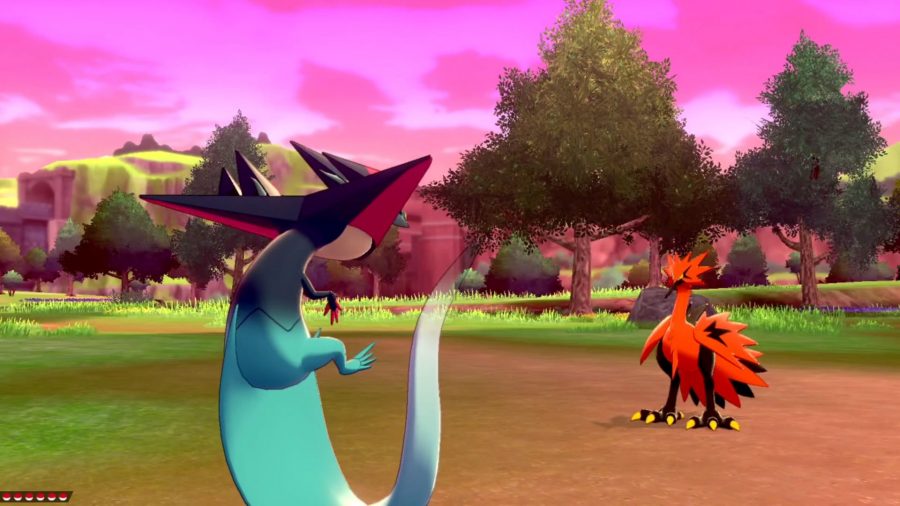While the Pokémon universe is present in pretty much every genre of gaming these days (even MOBAs aren’t safe thanks to the upcoming Pokémon Unite) sometimes, for the best competitive experience, you’ve got to go back to basics: a good old fashioned, no nonsense, Pokémon battle.
Pokémon Sword and Shield gives fans the opportunity to flex their competitive muscles against one another in not only monthly competitive seasons but also in Ranked Series, which have ever changing rulesets for players to compete within.
It’s now time for Ranked Series 9, which kicked off on May 1. Series 9 goes back to the competitive ruleset of Series 7 and is taking away some of the monstrously powerful restricted legendary Pokémon that were permitted for use in Series 8. This shifts the impetus back onto some of The Crown Tundra’s best Pokémon, plus some other seriously strong ‘mons, and you’ll be able to get our opinion on some of the best later on in this guide.
We’re going to briefly go over some of the important rules and restrictions for Ranked Battles newcomers, which Pokémon are eligible for Season 9, and which Pokémon look to define the meta for the next few months.
When is Pokémon Ranked Series 9?
Pokémon Ranked Series 9 began on May 1 and should end on July 31.
Pokémon Ranked Series 9 ruleset
For those new to competitive play in main series Pokémon games, you’ll first need to know what the rules and regulations are for Ranked Battles
While the entire 27-page VCG rulebook goes into every possible nook and cranny of competitive play, including what will happen to you if you’re caught cheating, we’ve cherry picked the important rules for Ranked Battles that you need to know.
Series 9 continues to be a double battle format, meaning you and your opponent will start with two Pokémon on the field. You pick a team of six Pokémon, which is then shown to to the other player, and visa versa. You must then select which four Pokémon you want to take into battle with you, based on your opponents lineup of ‘mons.
Ranked single battles are also available with a separate ranked ladder for you to climb. However, double battles are the main competitive format.
Series 9 will revert back to the same rules around eligible Pokémon as Series 7, completely banning restricted legendary and mythical Pokémon.
Players have access to all Pokémon in the Galar, Isle of Armor, and The Crown Tundra Pokédexes, as well as a few other groups such as starters from the Hoenn and Alola regions or Ultrabeasts.
Pokémon you bring into battle must have been acquired in Pokémon Sword or Shield, or you can use Pokémon from previous games that you’ve transferred in via Pokémon HOME – but they must have the Battle Ready symbol next to their name (this essentially means that any moves not featured in Sword and Shield have been forgotten).
You can enter eligible Pokémon of any level but all of them are automatically levelled up or down to Lv 50 to make the battle fair.
Like in the main game’s battles, you are allowed only one Dynamax/ Gigantamax per match.
While there are plenty of other rules to uphold competitive integrity, these are the basics you need to know before going in for a Ranked Series battle.
Ranked Series 9 banned Pokémon and eligible Pokémon
For Pokémon Ranked Series 9, players have a massive pool of Pokémon to choose from to form a powerful team.
These are the Ranked Series 9 eligible Pokémon:
- Galar Pokedex: #001-#397
- Isle of Armor Pokedex: #001-#210
- The Crown Tundra Pokedex: #001-#209
- Raikou, Entei, and Suicune
- Hoenn region starters (Swampert, Blaziken, and Sceptile lines)
- Latias and Latios
- Uxie, Mesprit, and Azelf
- Heatran
- Cresselia
- Tornadus, Thundurus, and Landorus
- Alola region starters (Incineroar, Primarina, and Decidueye lines)
- Tapu Koko, Tapu Bulu, Tapu Fini, and Tapu Lele
- All Ultrabeasts
In short, pretty much any Pokémon available in the Generation 8 games, plus a few extras, are eligible for Series 9.
These are the banned Pokémon for Ranked Series 8:
- The following legendary Pokémon: Mewtwo, Lugia, Ho-Oh, Kyogre, Groudon, Rayquaza, Dialga, Palkia, Giratina, Reshiram, Zekrom, Kyurem, Xerneas, Yveltal, Zygarde, Cosmog, Cosmoem, Solgaleo, Lunala, Necrozma, Zacian, Zamazenta, Eternatus, and Calyrex.
- The following mythical Pokémon: Mew, Celebi, Jirachi, Victini, Keldeo, Genesect, Diancie, Volcanion, Magearna, Marshadow, Zeraora, Meltan, Melmetal, and Zarude.
Strongest Pokémon in Ranked Series 9
It’s relatively easy to say which Pokémon will dominate in Ranked Series 9 as it is the same ruleset as Series 7.
Series 7 was dominated by new Pokémon introduced in The Crown Tundra DLC, including Regieleki and one of the new legendary horses, Glastrier. We expect these Pokémon to be popular once again in Series 9. Plus, Pokémon such as Garchomp and Landorus will likely continue to be strong choices in ranked play, as will some of the most-used Pokémon that were banned in Series 6 like Incineroar or Dragapult.
Elsewhere, the likes of Dracozolt, Urshifu, and Gigantamax Lapras are all established threats which will continue to be dangerous.
Pokémon Ranked Battles tiers
For ranked play in Pokémon Sword and Shield, there are five different tiers that players work their way through. Each tier is reached when you hit a certain level.
These are the tiers for Pokémon ranked play:
- Beginner (Level 1-3)
- Poke Ball (Level 4-6)
- Great Ball (Level 7-9)
- Ultra Ball (Level 10)
- Master Ball (Max level)
Remember, there are separate ranking systems to climb for both single and double battles.
So that’s everything you need to know about Ranked Battles and Ranked Series 9 in Pokémon Sword and Shield. If the meta or rules begin to change throughout the Series, we’ll be sure to update this guide. Happy battling!



